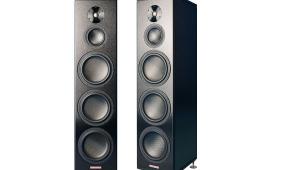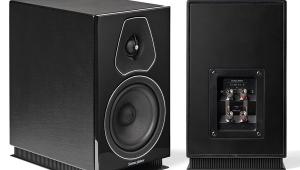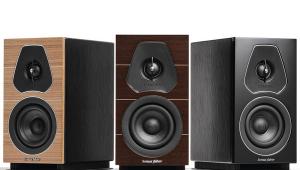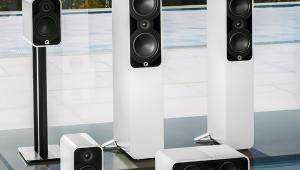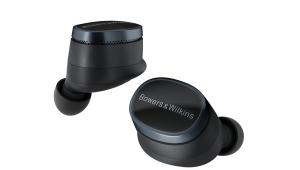Duevel Venus
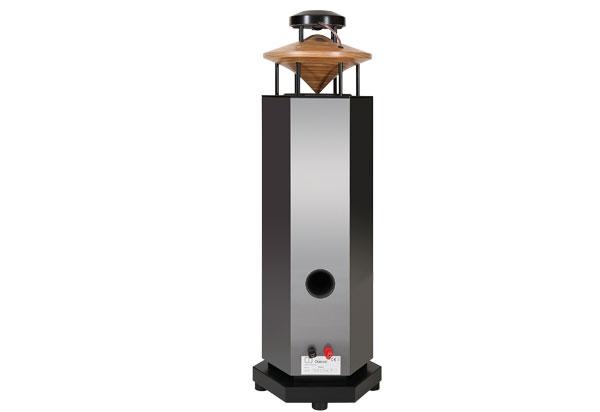
 As hard as they try, due to their very physics it’s often difficult for speakers to be worthy of the ‘Exotica’ tag that’s attached to this section of HFC. They are, after all, in the simplest of terms a series of drivers (admittedly made from increasingly enticing materials) configured in a cabinet – invariably made from wood. Aside from colour, size and finish there’s not really a lot to separate, say, a £500 speaker from a £5,000 when it comes to aesthetics. So it comes as a welcome novelty to deliver something that really can be considered exotic in so many ways.
As hard as they try, due to their very physics it’s often difficult for speakers to be worthy of the ‘Exotica’ tag that’s attached to this section of HFC. They are, after all, in the simplest of terms a series of drivers (admittedly made from increasingly enticing materials) configured in a cabinet – invariably made from wood. Aside from colour, size and finish there’s not really a lot to separate, say, a £500 speaker from a £5,000 when it comes to aesthetics. So it comes as a welcome novelty to deliver something that really can be considered exotic in so many ways.
First off there’s the whole issue of directionality. For as long as there have been loudspeakers, arguments have raged as to the best way for them to radiate sound. ‘Regular’ cabinets fire their sound in one direction: forwards towards the listener, meaning that they need to be placed around the boundaries of the room and you need to be in their line of sight for the optimal performance. But the lesser spotted omni-directional speaker – as the name suggests – can radiate sound in every direction to create a convincing soundstage regardless of where you stand in the room. Popular in the seventies – with the likes of Sonab and Canon enjoying some success with the concept and the late Siegfried Linkwitz the format’s most outspoken champion – the omni-directional speaker is about as common today as flared trousers, but that’s not to suggest it’s about as functional.
German husband-and-wife team Anette and Markus Duevel created the prototype of their first radial loudspeaker in 1997, in the shape of the Jupiter. Since then, the couple have gone on to unveil a series of increasingly exotic omni-directional cabinets usually with monickers relating to other celestial bodies. As they wisely observe: “Why would you choose to turn your back on a well proven system and decide to walk a completely different way?”
The original Venus followed three years later and today is positioned towards the lower end of the Duevel range with the Planets and Enterprise beneath it and the increasingly Heath-Robinson-esque Bella Luna ‘Diamante’, Orion, Sirius and Sirius BE above it.
In the subsequent 20 years since its launch, the Venus has undergone a series of tweaks and updates until finally settling upon the glorious hexagonal enclosure that you see before you. The rear-ported cabinet features a 220mm bass driver at its top, directing sound upwards towards the disc reflector. Meanwhile, a 30mm soft dome tweeter is supported by pillars and fires its sound down towards said reflector. The upper and lower profiles of the spinning-top-shaped reflector are different in order to better handle the dispersion of the different frequency responses being sent their way.
Little in the way of detail is provided by Duevel about the crossover, which is described as being of the “phase linear” variety, but what we can tell you is that the PCB is located in the bass of the hexagonal cabinet as far away as possible from the mid/bass driver’s potentially damaging magnetic field and local output. A series of bracing is applied along with damping pads on every internal surface and a single set of 4mm binding posts is on hand for hookup. These are chunky, easy to tighten and positioned far enough away from one another to avoid potential issues if utilising bare-wire connections. Standard finishes include Black, Macassar, Maple and Padouk, although Duevel’s website has the Venus showing off a selection of other exotic finishes – presumably available at an additional cost.
Sound quality
This being an omni-directional loudspeaker, the need to have the Venus pushed up against the boundary wall is less significant than with regular directional models. Consequently, a little experimentation reveals that moving the cabinets around two feet into the room removes the slight sense of congestion that blights the soundstage while calming down the obvious hardness of the upper treble. Naim’s Supernait integrated amplifier is employed throughout auditioning along with its CD5XS/Flatcap XS disc spinner and a Michell Gyro SE/SME 309/Clearaudio MC Essence vinyl front end.
Typically for omni-directional cabinets the first thing to note is that instead of there being a succession of musicians and performers clearly discernible in specific areas of the soundstage, there is a huge swathe of sound that spreads across the entire front of the listening area. And, while with ‘regular’ speakers, it’s easy to close your eyes and still pick out precisely where the cabinet is in the room, the same certainly isn’t the case here. As disappearing acts go, the Venus is right up there with Lord Lucan’s finest work.
As impressive as all of this may be, the real magic of the Venus is the image stability it offers. Stand in the corner of the room, lie down flat on the sofa, stand on a chair... no mater what curious positions we adopt in the listening room, the change in performance is pretty much negligible. There may be a slight softening of the treble and miniscule loss of focus in the vertical plane if you stand at the very extremes, close to the walls, but otherwise the performance remains immune to movement around the room, making it ideal for entertaining more than one listener.
As mentioned earlier, the resulting soundstage is less ‘pin-point’ meaning that rather than the vocals on The Highwoman’s eponymous album being centre stage in front of you, there’s more of a sense of the whole band just being ‘there’ in the room. The result is that you can’t accurately locate definite positions for the multiple layers of instrumentation, and once you get used to this different way of listening the effect becomes addictive.
No matter what we play – and believe us, the volume is cranked up and a good time is had by all – the treble remains insightful and detailed with vocal sibilants being a particular highlight. The precision and crispness is incredible and the way that it arrives at the listening position before swiftly vanishing again is astonishing. Similarly the low end is impressively deep, while remaining taut and precise throughout. From the banging beats of Jamie XX’s Gosh to the more subtle, fruity warmth of Julianna Raye’s Indigo River, the results offer the same jaw-dropping encounter.
The only drawback, if it can even be considered as such, is that a hefty amplifier is essential to fully realise the Venus’ true potential.
Conclusion
Listening to an omni-directional speaker is completely different to regular cabinets, and the Venus is a master of the art of ‘disappearing’. The way it essentially eliminates the sweet spot, offering up the same breath-taking results – regardless of position in the room – make it an absolute must-audition. The effect may not be for everyone, but there’s no doubt that this is a uniquely captivating sonic experience. HFC
DETAILS
Product: Duevel Venus
Type: Omni-directional 2-way loudspeaker
FEATURES
● 33mm soft dome tweeter
● 220mm carbon fibre mid/bass driver
● Quoted sensitivity: 88dB/1W/1m (4ohm)
 |
Inside this month's issue:
Q Acoustics 3020c standmount loudspeakers, Perlisten R10s active subwoofer, Quad 33 and 303 pre/power amps, Acoustic Solid Vintage Full Exclusive turntable, newcomer Fell Audio Fell Amp and Fell Disc and lots, lots more...
|









